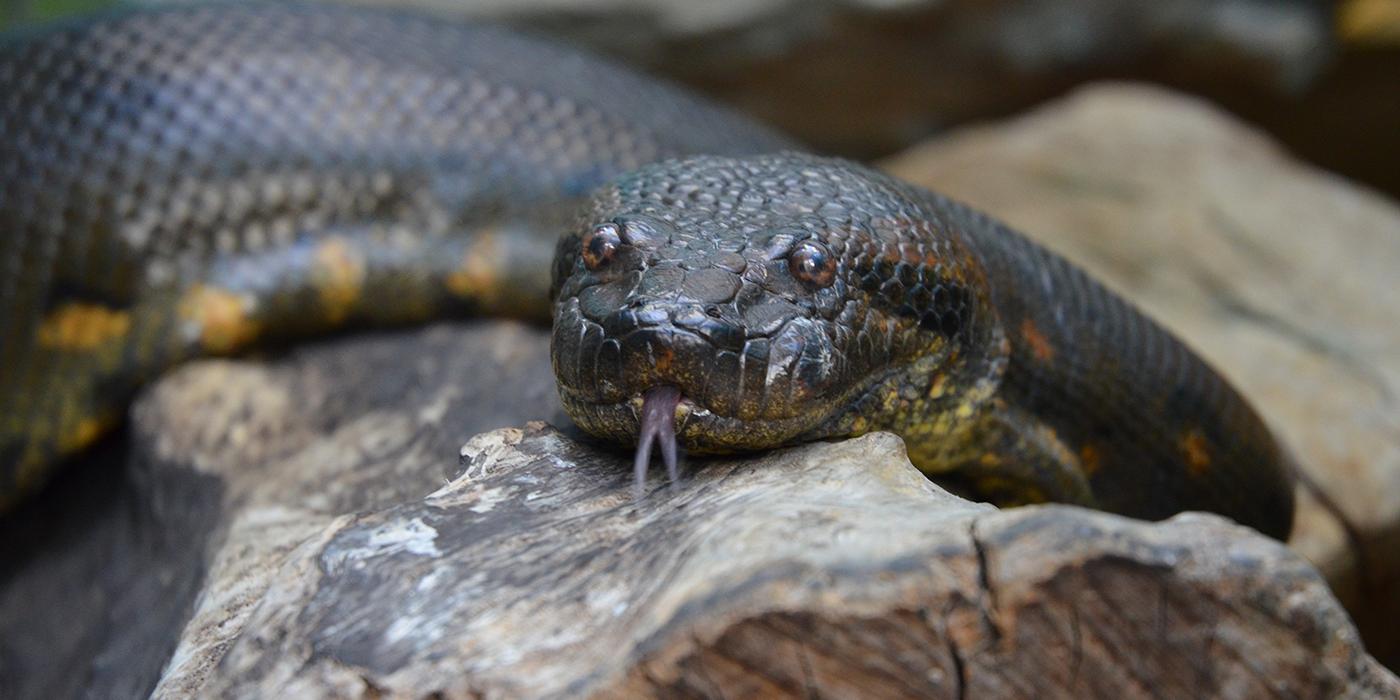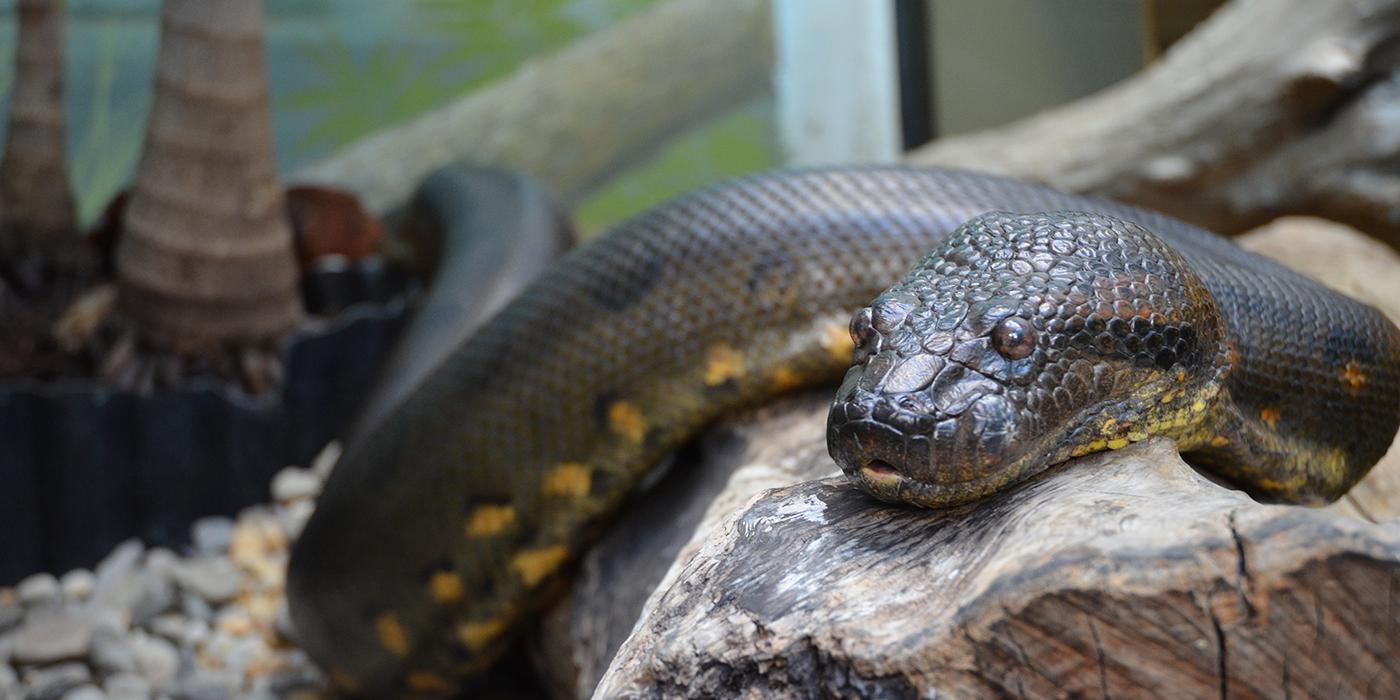Physical Description
These anacondas are olive-green with dark oval spots along their spines and similar spots with yellow centers along their sides. The scales on their belly are yellow and black. They also have two dark stripes from their eyes angling toward their jaws. Their color and pattern provides camouflage, allowing them to blend in with the wet, dense vegetation of their habitat.
Green anacondas are well adapted to aquatic life. Their nose and eyes are located on the top of their heads to help them see and breathe while swimming in the water. Anacondas that live in areas that flood seasonally must find water during the dry season or burrow into the mud.
Full-grown adult females have few predators due to their size. However, juveniles and males must protect themselves from predators. They escape by burrowing into the mud or retreating to water. When cornered, they coil into a ball in order to both protect their head and gain the ability to strike.
Size
Green anacondas are one of the largest snakes in the world. Females are considerably larger than males. They can reach lengths of 30 feet (9 meters), diameters of 12 inches (30.5 centimeters) and can weigh 550 pounds (250 kilograms).
Native Habitat
Green anacondas are native to the northern regions of South America. They are most abundant in the Orinoco basin in Colombia, the Amazon River basin in Brazil, and the flooded Llanos grasslands in Venezuela. They are also found in Ecuador, Peru, Bolivia, Guyana, Paraguay, French Guiana, and Trinidad.
Green anacondas generally live in tropical rainforests and tend to prefer shallow, slow-moving waters, such as streams, rivers and flooded grasslands. They spend most of their time in the water but are also found on land in thick vegetation, often in trees.
Lifespan
Their average life span in the wild is about 10 years. However, they live much longer in human care, with some reports of anacondas living into their late 20s.
Communication
Anacondas have advanced chemosensory abilities and are able to uses their tongues to detect chemical signals from nearby animals. Males also use this ability to detect pheromones from females during the breeding season. They will flick their tongues to pick up the chemical presence in the air. Anacondas also detect the presence of other animals through vibrations and by using pit organs on their upper lip to identify heat signatures.
Food/Eating Habits
Like all snakes, green anacondas are carnivores. As members of the boa family, green anacondas are nonvenomous constrictors. They use their strong jaws to capture their prey, then use their muscular bodies to suffocate the prey before swallowing it whole. Like most snakes, they can detach their jaw to swallow prey much larger then themselves, though they are careful to weigh the risk of injury with large prey. Green anacondas have slow metabolisms, and with the exception of breeding females, only need to eat once every few weeks.
They are opportunistic apex predators and eat a wide variety of prey. Juveniles tend to eat fish, birds and small mammals. Adults are able to consume much larger animals, including deer, capybara, caimans and large birds. Females will sometimes cannibalize males, especially during breeding season. Due to their immense size, green anacondas are one of the few snakes that could be capable of consuming a human. However, there are no recorded instances of a green anaconda doing so.
At the Smithsonian's National Zoo, the green anaconda eats rats and rabbits about once a month.
Social Structure
Anacondas are typically solitary creatures that stay within their own hunting areas, except during the breeding season.
Reproduction and Development
Green anacondas reach sexual maturity at about 3 to 4 years old. Mating generally occurs from March to May during the dry season. Males form groups of up to 13 snakes and mate with one female. They form a “breeding ball,” where the males surround the female and compete for access to her cloaca. The mating can last for up to a month, in which time the female will mate several times. Afterward, the female may consume one of more of the smaller males, as she will not eat again for the seven month gestation period. Green anacondas only mate every other year, likely due to the large amount of energy loss.
Females give live birth in the water after sheltering through the rest of the dry season and can give birth to 20-40 young. The size of the litter is generally associated with the size of the female. The largest litter on record was 82 young.
Conservation Efforts
Like many rainforest species, habitat loss is a threat to green anacondas. Protected areas are not always well regulated and deforestation still occurs. Green anacondas are also hunted by people. Many people fear anacondas due to their large size or may kill them to protect livestock.
There is a large market for anaconda products, and these snakes are also captured for the international pet trade. The trade of anacondas is regulated under CITES Appendix II, but illegal trade persists. Some countries have additional national laws making the trade of anaconda products illegal.
Help this Species
Practice ecotourism by being an advocate for the environment when you’re on vacation. During your travels, support, visit or volunteer with organizations that protect wildlife. Shop smart too! Avoid buying products made from animals, which could support poaching and the illegal wildlife trade.
Choose your pets wisely, and do your research before bringing an animal home. Exotic animals don’t always make great pets. Many require special care and live for a long time. Tropical reptiles and small mammals are often traded internationally and may be victims of the illegal pet trade. Never release animals that have been kept as pets into the wild.
Share the story of this animal with others. Simply raising awareness about this species can contribute to its overall protection.
Smithsonian's National Zoo and Conservation Biology Institute. (n.d.). Green anaconda. Retrieved October 20, 2025, from https://nationalzoo.si.edu/animals/green-anaconda
Animal News

7 Spooktacular Animal Facts for Halloween ›

Meet the Orangutans Living at the Smithsonian’s National Zoo ›


